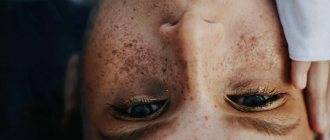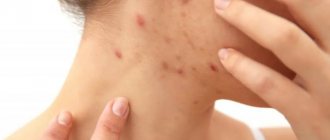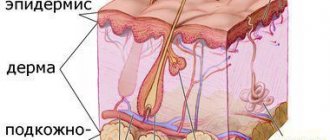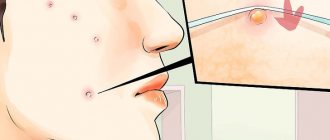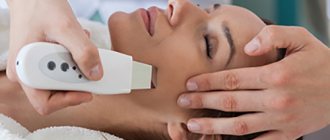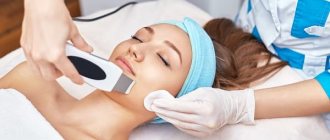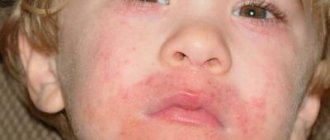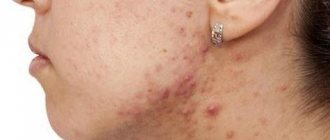Naturally ideal skin is extremely rare, and millions of people around the world face problems such as acne, comedones, enlarged pores, dehydration and other imperfections. Most often, acne and acne occur during adolescence due to hormonal changes in the body, but skin rashes can also appear in adulthood, causing certain difficulties. We talk about what types of acne there are, what procedures exist to treat the disease, what causes acne, and what cosmetics are recommended to use in our article.
Acne - causes, types
Acne usually occurs during hormonal surges. Therefore, they appear not only in adolescents, but also in pregnant women, in women during a change in the phase of the menstrual cycle, during malfunctions of the endocrine or digestive system, when taking steroids or prolonged contact with chemicals.
There are several types of acne:
- Comedones are plugs consisting of a mixture of horny particles of the epidermis and sebum, one of the signs of hyperkeratosis. The closed form is whiteheads; open - blackheads or, in common parlance, “blackheads”.
- Papules are formations that protrude above the surface of the skin. Usually formed from closed comedones. Depending on the size and depth, they can heal without leaving a mark if they are located superficially, or they can form scars up to hypertrophic and keloid if the deep layers of the epidermis and dermis are affected. On areas of the skin affected by papules, erythema of varying severity is observed.
- Pustules can be the next stage of development of papules; they differ from them in the presence of pus, which can come to the surface of the skin in the form of a white head.
- Nodular cystic acne is a serious complication when pustules affect the lower layers of the dermis, forming fistulas in them through which the infection spreads. Extremely painful. Need urgent treatment.
- Acne fulminans is the most severe form of the disease. It is characterized not only by significant damage to the deep layers of tissue, but also by changes in blood composition, increased temperature, and severe pain in the skin, bones and muscles. Requires surgical medical intervention.
Degrees of development of acne and methods of treatment:
- Comedones predominate; papules and pustules may be present in small quantities.
- Almost the entire surface of the face is affected, and there are rashes on the body. Qualitative composition: comedones, papules and pustules.
- Papules and pustules predominate. A strong inflammatory process is observed. Redness of the skin and itching may occur. Post-acne appears.
- Extreme degree of inflammation. Characterized by pimples more than 5 mm in diameter, leaving behind atrophic scars. Severe erythema is observed. The deep layers of the dermis are affected.
Whatever the stage of the lesion, acne is a disease and needs to be treated. Otherwise, the appearance of defects in the form of uneven skin texture, scars and enlarged pores is inevitable. They are much more difficult to remove.
Teenage acne of degrees I and II can be treated with anti-acne creams and masks. Stages III and IV require systemic treatment, including antibiotics and hormonal drugs.
Acne in adults requires elimination of the root cause - a hormonal imbalance or primary disease, exposure to acnegenic substances, as well as discontinuation of medications that caused the disease. Carrying out simultaneous treatment procedures will avoid complications and the appearance of cosmetic defects.
The New Line modern medicine clinic offers the most modern and effective methods of treating acne at any stage. There are various methods that can be used either independently or in various combinations. The course is selected individually by a specialist, depending on the patient’s condition.
Stages of a facial cleansing procedure for problem skin
At Ego Estetic, the facial cleansing procedure for acne is carried out using a special, uniquely developed method and includes many important steps:
- make-up remover – a cosmetologist removes decorative cosmetics from the face
- scrub-gommage – superficial skin cleansing
- chemical peeling with alpha acids - a cleansing procedure that allows you to remove the upper stratum corneum of the skin
- steaming mask - a procedure that helps open the pores of the face
- Ultrasonic peeling – cleansing the surface layer of the skin from old, dead cells using a hardware method
- facial cleansing – direct cleansing of pores mechanically
- removal of comedones, milia
- antiseptic mask – has a disinfecting and soothing effect
- therapeutic and soothing massage according to Jacquet - enhances the effect of a cosmetic mask, has a tightening, toning and relaxing effect
- alginate (algae) mask with a pronounced soothing, moisturizing effect
- applying the cream is the final stage, helping to nourish and moisturize the skin of the face, as well as its restoration after cleansing
Methods of hardware cosmetology in the fight against acne
In hardware cosmetology, there are two methods of treating acne:
- Ultrasonic cleaning. One of the most effective procedures. It prevents the cause of the disease - clogged pores. During the session, the cosmetologist treats the surface of the skin with an ultrasonic scrubber. The vibrations created by the device break the bonds between the cells of the stratum corneum and exfoliate them. High-frequency vibrations knock out all accumulated impurities and dead cells from the skin.
- Darsonvalization is a physiotherapeutic procedure for influencing the skin with microcurrents. As a result, metabolic processes are stimulated in all layers of the skin, and the functioning of the sebaceous glands is stabilized. There are two types: remote, when the effect is on the superficial layers, and contact, in which the effect is on the deep layers of the dermis.
Diagnosis of acne: symptoms and types
Acne, also known as acne, is one of the most common skin diseases. It is an inflammation of the skin. The appearance of acne is caused by increased work of the sebaceous glands, increased proliferation of pathogenic bacteria and an increase in the number of keratinized cells in the epidermal layer. As a result, unsightly pimples called acne appear on the skin.
Acne can be localized on any part of the body, but most often it affects the face. One of the most unpleasant consequences that acne causes is post-acne (scars or spots that appear on the skin due to improper care or treatment, as well as subsequent squeezing of pimples).
There are several stages of acne, each of which is characterized by a certain degree of manifestation:
Comedonal is the most initial and mildest degree of acne. There is no inflammation, there are closed or open comedones on the skin, as well as reddish pimples without purulent contents. The number of comedones and acne on the skin at the initial stage does not exceed ten pieces.
Papulopustular is a moderate stage of acne, in which the number of comedones and papules increases. Inflamed pimples with purulent contents appear. You may feel discomfort when touching the skin.
Nodular is a more severe stage of acne, in which the number of pimples can reach seventy. Inflammatory areas grow, purulent papules can connect with each other, forming nodes. This form requires long-term and complex treatment.
Acne is the most severe form of acne, in which the number of papules, comedones and pustules increases significantly. Acne can affect the entire face, and painful boils appear under the skin. There is severe pain in the skin. The acne stage requires qualified help and competent treatment.
Peeling
Peeling is the process of exfoliating dead cells from the surface of the skin. It is carried out using various drugs that help dissolve the stratum corneum. In addition to preventing acne, such procedures help whiten, remove acne scars, freckles and age spots, and even out the appearance.
Their action is based on the skin's reaction to the burn. The drug actually burns the epidermis layer. The depth of effect depends on the concentration of the active substance. The skin responds by increasing metabolism and regeneration processes.
Peeling is usually carried out during periods of decreased solar activity. The skin after the procedure is characterized by increased sensitivity and a tendency to form pigment spots, so autumn and winter are the ideal time for the procedure.
Our clinic offers two types of peelings for problem skin:
- Acne peeling with a drug from IMAGE Skincare (USA). Recommended for skin of I and II degree of damage, with hyperkeratosis, comedones, acne spots, enlarged pores and increased oiliness.
The drug is based on aloe vera. The main active ingredients are salicylic and glycolic acids; in addition, extracts of medicinal plants are used that have whitening and anti-inflammatory effects.
- Salicylic-azelaine peeling from Juliette Armand (Greece). Designed for oily skin prone to acne. Exfoliates the top layer of the epidermis, deeply cleanses and mattifies, removes age spots, tightens pores.
The main active ingredients are salicylic and azelaic acids. Their combination has not only a powerful cleansing effect, but also an anti-inflammatory effect.
Peeling procedure stages:
- Consultation with a cosmetologist and selection of the drug.
- The skin is completely cleansed of makeup and oil
- The doctor applies peeling to the skin starting from the forehead and going down to the chin.
- The drug is aged for fifteen minutes to an hour. During the process, a burning sensation of varying severity may be felt, depending on the sensitivity of the skin and the concentration of the acid.
- A neutralizer is applied.
- Residues of the product are removed from the skin.
- A soothing cream or mask is applied.
Post-procedure care:
- during the first 24 hours after peeling, you should not use cosmetics, wash your face or touch the skin;
- in the next three days it is necessary to limit physical activity and the use of oily cosmetics. It is recommended to use moisturizers and anti-inflammatory agents;
- Throughout the entire rehabilitation period, it is necessary to use sunscreen with an SPF factor of at least 30 units, regardless of the time of year. This will prevent the risk of age spots. It is also necessary to refrain from visiting a solarium, bathhouse or sauna. Do not remove crusts and peeling mechanically.
The final result appears approximately two weeks after the session. It is advisable to carry them out in courses, at intervals, on the recommendation of a cosmetologist.
Contraindications for peeling:
- inflammatory processes on the skin;
- sensitivity to the components of the drug;
- pregnancy and lactation;
- neoplasms;
- rosacea;
- herpes.
How to treat acne in teenagers and adults?
It is commonly believed that acne is a teenage problem, but this is not true. You can experience acne even after 25 years of age. Since acne is a physiological, not an aesthetic problem, cosmetic procedures for it can only be auxiliary, and the main course of therapy can be medicinal. A doctor must draw up a course of treatment.
Azelaic acid (AA) preparations are used in the treatment of acne9. They are mainly represented by 20% creams and 15% gels. Studies show that the penetration of AK from the gel is 2.5 times better than from the cream18.
Azelik® – 15% azelaic acid gel. Thanks to its micronized structure, AK easily penetrates the dense stratum corneum, dissolving in the channels of the sebaceous glands. Azelaic acid helps reduce the level of fatty acids, reduce the colonization of propionibacteria and Staphylococcus epidermidis, and normalize keratinization processes5. Its anti-inflammatory effect can be explained by its ability to reduce the metabolism of neutrophils and reduce their synthesis of free radical oxygen species5.
Azelik® can be used from 12 years of age5. The drug should be applied twice a day to clean, dry skin5.
*acne
Injection procedures
These techniques can improve the condition of the skin and reduce problems that already exist. Usually meso cocktails are used, which differ in their composition. Their goal is to combat skin oiliness, pigmentation, and strengthen the skin’s immunity.
Laser treatment methods
Laser is a procedure that is popular among women and demonstrates high efficiency. The laser beam targets bacteria that cause acne. And eventually the bacteria die. Hardware methods can reduce acne, prevent its further occurrence, and lighten the marks that remain after rashes.
The effect of the procedure lasts for a long time. In most cases it does not cause pain, but in some cases there may be a tingling sensation. It is important to ensure proper skin care after using a laser.
Phototherapy
This type of treatment has emerged recently, but has already demonstrated its effectiveness in the fight against acne. During the procedure, flashes of light are applied to the skin. They are short-lived, but very strong.
The specialist initially makes adjustments to the length of the flashes. This takes into account the skin problem. Outbreaks affect porphyrin, which is the result of bacteria that can cause acne. If you combine waves with different sizes, you can make your skin less oily and reduce the amount of inflammation.
Skin care treatments
A cosmetologist can also help with choosing skincare treatments that have a positive effect on acne and can reduce the severity of the disease. For example, a doctor may prescribe enzyme serums, masks that improve immunity, concentrates (ampoules, keratolytic). On their basis, alginate masks are created that are used for problem skin.
To understand which cosmetic procedures will be effective in a particular case and will cope with acne, you should first visit a cosmetologist. He studies the clinical picture, determines the problem, the cause of acne, and then selects the appropriate treatment.
